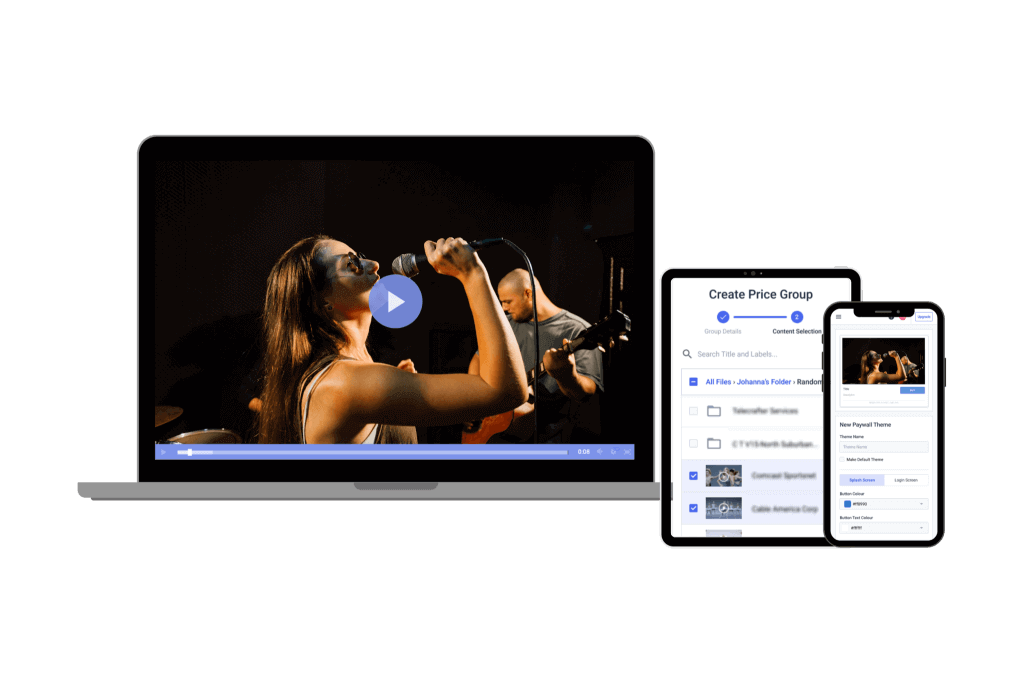Top 115+ Live Streaming Statistics Every Broadcaster Must Know in 2025
The live streaming industry is growing faster than ever. However, some people are still unsure whether or not incorporating professional broadcasting into their business is worth it.
We’ve put together the top 115 live streaming statistics that show the growth and current state of the video streaming industry. With these numbers in mind, you should have a clearer image of what live streaming could look like for you.
There is a lot of new information to present and there is a lot to cover. Let’s get started!
Table of Contents:
- Global Live Streaming Market Growth
- How Do People Watch Live Streams?
- Streaming Tech Trends and Quality in 2025
- Live Streaming for Business and Marketing
- Streaming Stats for Live Events
- Live Video Monetization Statistics
- Live Streaming Industry Security Trends
- Live Video in Education
- Live Streaming Industry Trends and Statistics
- AI, Automation and FAST Channels in Live Streaming (2025)
- Streaming for Retail and Live Commerce
- Codec and Streaming Quality Updates
- FAQs
- Conclusion
This post has been updated to reflect the 115+ most accurate live streaming statistics and unique research available as of June 2025.
The Growth of Live Streaming in 2025

1. Live streaming is growing fast. One report, for example, shows that “Live video grew by 93%, with an average viewing time of 26.4 minutes per session.” (Streaming Media, 2019)
2. Live videos hold users’ attention 10-20x longer than pre-recorded, on-demand content. (Forrester, 2017)
3. Of all people who report that they watch live streams, 7 out of 10 of them tune in to a live stream daily. (Interactive Advertising Bureau, 2018)
4. The live music event with the highest live viewership was 2019 Coachella at about 82.9 million live views. (Variety, 2020)
5. The video streaming market will grow to $223.98 billion by 2028
6. The online live streaming industry has grown 99% between April 2019 and April 2020. (Tech Jury, 2020)
7. The live streaming industry is expected to be valued at 184.27 billion USD by 2027. (Tech Jury, 2020)
8. Millennials are the largest group of consumers of live content. 63% of people ages 18-34 are watching live-streaming content regularly. (Neil Patel, 2018)
9. Approximately 34% of Generation Z (who were born between 1997 and 2015) have shown a new interest in live streams, especially on social platforms. (GWI Flagship Report 2020)
10. Younger generations (Gen Z and Millenials) spend more time streaming, whereas older people (Boomers and Gen Xers) watch more broadcast TV. (GlobalWebIndex)
11. Professionals anticipate that 82% of internet use will be for streaming video by 2022. (Cisco, 2021)
12. Professionals also anticipate that 79% of mobile users will be streaming video by 2022. (Cisco, 2021)
13. Access to exclusive coverage is the reason why 26% of viewers tune into live streams. (GWI Consumer Trends Report 2019)
Live streaming continues to grow rapidly, shaping how people consume video across generations and platforms. The market size is expanding, with projections exceeding $180 billion by 2025. Younger audiences, especially Gen Z and Millennials, are driving much of this growth, spending more time watching live streams on social and OTT platforms. Engagement with live content is strong, with viewers tuning in daily and staying attentive much longer than with on-demand videos. Exclusive content and real-time interaction remain important reasons viewers choose live streams. These trends highlight opportunities for broadcasters, educators, churches, and businesses to tap into growing live streaming demand using the best platforms and strategies available today.
Key takeaways:
- The live streaming market is booming, with strong growth expected through 2028 and beyond.
- Gen Z and Millennials are the most active live streaming audiences, influencing platform trends.
- Live video engagement outperforms on-demand content in attention and daily viewing habits.
- Exclusive live coverage and interactivity drive viewer loyalty across sectors like education, faith-based streaming, and corporate events.
- Understanding OTT streaming statistics 2025 and TikTok live stream statistics 2025 can help content creators and businesses optimize their live streaming strategies.
| Metric | 2019 | 2025 |
|---|---|---|
| Live video growth rate | 93% growth | Market size expected to exceed $180 billion |
| Average viewing time per live session | 26.4 minutes | Engagement remains strong |
| Daily live stream viewers | 70% tune in daily | Strong daily viewership continues |
| Largest live music event viewership | 82.9 million (2019 Coachella) | No update |
| Live streaming industry value | $184.27 billion (expected by 2027) | $180+ billion estimated |
| Growth rate (April 2019 – April 2020) | 99% growth | Continued rapid growth projected |
| Largest live streaming audience group | Millennials (63% ages 18-34) | Gen Z and Millennials remain dominant |
| Interest from Gen Z | 34% showed new interest in live streams | Gen Z continues to drive growth |
| Shift in viewing habits | Younger generations stream more; older prefer TV | Same trend continues |
| Percentage of internet use for streaming | 82% expected by 2022 | Streaming remains dominant |
| Mobile users streaming video | 79% expected by 2022 | Mobile streaming continues to grow |
| Reason for tuning in live streams | 26% access exclusive content | Exclusive content remains a key driver |
How Do People Watch Live Streams?
14. U.S. cable subscriptions are declining sharply.
As of 2025, around 68.7 million U.S. households still have cable TV—a drop from 76 million in 2022—indicating cord-cutting continues at a steady pace (explodingtopics.com, evoca.tv).
15. The U.S. video streaming audience continues to grow.
In 2023, 62% of U.S. adults were subscribed to at least one video streaming service, compared to 60% in 2022 (kommandotech.com). The U.S. video streaming market reached $22.42 billion in 2024, up from $18.79 billion in 2023 (grandviewresearch.com).
16. Most people now watch internet videos deliberately.
Globally, 67% of people have watched streaming video, and 47% say they watch more live streams year over year, indicating increasing demand (kommandotech.com).
17. Mobile users spend more time streaming.
On mobile devices, viewers watch an average of 16 minutes of video per day, while desktop users watch 7 minutes daily, consistent with recent trends (99firms.com).
18. Average live session length is rising.
Now, viewers spend about 25.4 minutes per session watching live videos—significantly longer than older averages (demandsage.com).
As cable subscriptions continue to decline in the U.S., more viewers are turning to streaming services, fueling steady growth in the video streaming market. In 2025, over 60 percent of U.S. adults subscribe to at least one OTT platform, reflecting shifting preferences away from traditional TV. Mobile streaming is becoming increasingly important, with users spending more time watching videos on smartphones than desktops.
Additionally, live streaming sessions are growing longer, showing rising engagement with real-time content. These trends highlight the ongoing shift in viewer behavior and emphasize the importance of platforms that support quality live experiences, from virtual events to church streaming and corporate broadcasts. Broadcasters should pay attention to these statistics on live video engagement to stay ahead in the evolving market.
Key takeaways:
- Cable subscriptions are declining as more viewers switch to streaming services, with over 60 percent of U.S. adults subscribing to at least one OTT platform in 2025.
- Mobile streaming continues to grow, with users spending more time watching video on smartphones than on desktops.
- Live streaming sessions are getting longer, indicating increased viewer engagement with real-time content.
- Platforms that deliver high-quality live experiences—whether for virtual events, churches, or corporate use—are becoming essential for broadcasters to meet changing viewer preferences.
Streaming Tech Trends and Quality in 2025
The Importance of Live Streaming Quality
 19. Quality for live streams is improving rapidly. In fact, “live streams now have better buffering and video start time metrics than on-demand video.” (Streaming Media, 2019)
19. Quality for live streams is improving rapidly. In fact, “live streams now have better buffering and video start time metrics than on-demand video.” (Streaming Media, 2019)
20. The biggest quality issue for live video is now starting failure. Live streams fail to start 2.6% of the time. (Streaming Media, 2019)
21. Quality matters. OTT platforms with lower quality videos run the risk of losing about 25% of their revenue.
22. Online videos with a start-up time exceeding even two seconds have significantly higher streaming video abandonment rates, with each incremental second propelling another 6% of 23. viewers to jump ship. (Akamai)
23. About 66% of video streaming service providers have difficulty determining how much bandwidth they need for high-quality streaming. (Digital TV Europe, 2019)
Technologies’ Influence on Live Streaming
 24. H.264 remains the dominant codec, supported by 96.96% of browsers, and makes up 82% of the video processed by encoding.com. (Streaming Media, 2019)
24. H.264 remains the dominant codec, supported by 96.96% of browsers, and makes up 82% of the video processed by encoding.com. (Streaming Media, 2019)
25. The coming 5G cell networks will provide speeds roughly 100x faster than the best available 4G LTE networks. (Streaming Media, 2019)
26. 5G will cut latency by 10x. (Cisco, 2020)
27. 29% of consumers would pay a premium if 5G provided a better quality video on mobile devices and decreased buffering. (PWC, 2018)
28. Access to 5G is predicted to increase revenue from streaming on mobile devices by 85% from 2021 to 2028. (Intel, 2018)
Live streaming quality is improving quickly, with better buffering and start times than on-demand video. However, starting failure remains a key challenge, causing some viewers to abandon streams early. Quality directly impacts revenue, as OTT platforms with poor video quality risk losing about a quarter of their income. Viewer patience is short—startup delays over two seconds lead to higher abandonment rates. Many providers still struggle to estimate bandwidth needs for smooth streams.
On the technology side, H.264 remains the most widely supported codec, but emerging 5G networks promise much faster speeds and drastically lower latency. Nearly a third of consumers would pay more for improved mobile video quality through 5G, which is expected to boost streaming revenue significantly. These advances shape streaming trends for content creators, corporate live streaming usage, and education live streaming in 2025 and beyond.
Key takeaways:
- Live streaming quality is improving with faster buffering and startup times, but stream failures still cause early viewer drop-off.
- Poor video quality on OTT platforms can cost up to 25% of revenue, highlighting the strong link between quality and monetization.
- Startup delays longer than two seconds significantly increase viewer abandonment, emphasizing the need for smooth, fast starts.
- Emerging 5G networks will drive better mobile video quality and lower latency, with nearly one-third of consumers willing to pay more for enhanced experiences.
| Metric / Trend | 2019/2020 | 2025 |
|---|---|---|
| Buffering & start times | Live streams had better buffering and start times than on-demand video (Streaming Media, 2019) | Live streams now achieve sub-1-second latency and highly optimized start times using 5G and ABR (Red5Pro, 2025) |
| Stream start failure rate | Live streams fail to start 2.6% of the time (Streaming Media, 2019) | AI tools have helped reduce start failures and rebuffering by 30% or more (Haivision, 2024) |
| Revenue loss due to poor quality | OTT platforms risk losing ~25% of revenue with low video quality | Quality-driven monetization boosted by AI optimization and next-gen codecs, reducing revenue loss significantly |
| Viewer abandonment vs startup delay | Each additional second over 2 seconds increases abandonment by 6% (Akamai) | Viewers are 3.2x more likely to abandon streams if quality drops below 720p (Conviva, 2025) |
| Bandwidth estimation challenges | 66% of providers struggle to estimate bandwidth needs (Digital TV Europe, 2019) | AI-powered adaptive bitrate streaming used by 72% of platforms to optimize bandwidth dynamically (Gumlet, 2024) |
| Dominant codec | H.264 supported by 96.96% of browsers, 82% of encoding volume (Streaming Media, 2019) | AV1 adoption grew by 34% in 2024; H.266 gains traction for better compression (Bitmovin, Fraunhofer HHI, 2024) |
| Mobile network speeds & latency | 5G expected to be 100x faster than 4G LTE, latency cut by 10x (Cisco, 2020) | 5G live video delivery grew 42% in 2024, latency under 1 second on average when combined with ABR (Ericsson, Red5Pro) |
| Consumer willingness to pay for better video | 29% would pay more for better 5G video quality (PWC, 2018) | 65% of broadcasters use AI to optimize streams for better quality and lower latency (NAB Show Insights, 2025) |
Live Streaming for Business and Marketing
Video Streaming Statistics for Business
29. 77% of employees have experienced problems like buffering while streaming live video at work. (Streaming Media, 2018)
30. As of 2024, 55% of enterprises utilize live video for company-wide or departmental broadcasts. (Wainhouse Research 2024)
31. 53% of enterprises stream or broadcast live video within their organization at least once a week, with 29% doing so daily. (Wainhouse Research 2024)
32. 65% of enterprises surveyed reported live streaming to multiple locations. (Wainhouse Research 2024)
33. The top challenges faced by enterprise live streamers include:
- Live streaming to employees working remotely: 41%
- Live streaming from remote locations or conference centers: 39%
- Managing bandwidth in facilities: 36% (Wainhouse Research 2024)
34. 81% of enterprise live streamers display their live video streams or broadcasts on employee desktops, 64% on mobile devices or smartphones, and 31% use a combination of TVs and screens with set-top boxes. (Wainhouse Research 2024)
35. About 80% of marketing professionals say that video content is becoming more important in the business world. (4CInsights, 2019)
36. Live video campaigns boost video engagement by twice as much for influencer marketing. (RhythmOne, 2018)
37. Nearly a quarter of marketers have reported that live streaming is the most effective tool for promoting trade shows. (The Social Effect, 2019)
38. Two-thirds of marketers that target consumers use live streaming for marketing. (Content Marketing Institute, 2020)
39. Brands are forecast to invest more than $100 billion on video content by 2023. (Forrester, 2018)
40. Video marketers use video content to reduce the necessity of support calls. There are reports that support calls have been reduced by 43% thanks to videos. (Wyzowl, 2021)
41. In 2020, Facebook Live became an important part of marketing strategies where video content was already being used. This increase was about 32%. (Wyzowl, 2021)
Live Streaming Trends in Marketing
 42. Nearly 3/4 of millennials report that videos are helpful when they are comparing products while online shopping. (TechJury, 2020)
42. Nearly 3/4 of millennials report that videos are helpful when they are comparing products while online shopping. (TechJury, 2020)
43. 35% percent of marketers use live video. This is a rise of 20% year on year. (Mediakix, 2019)
44. In 2018, 60% of viewers conduct online searches while watching a live stream. (Neil Patel, 2018)
45. Animoto’s Social Video Forecast suggests that 76.5% of marketers and small business owners are seeing results with video marketing. (Animoto, 2016)
46. 79% of marketers say live video facilitates a more authentic interaction with an audience.
47. 61% of marketers say a benefit of live streaming video is that it creates content that can be viewed or repurposed later.
48. 60% of marketers say a benefit of live video is getting real-time audience feedback.
49. 82% of viewers say they prefer seeing a live stream rather than a brand’s social posts. (Tech Jury, 2020)
50. 80% of people would rather watch a live video from a brand than read their blog. (Tech Jury, 2020)
Live streaming is becoming essential for businesses, both internally and in marketing. Over half of enterprises use live video regularly for communication, often streaming to multiple locations and devices. While challenges like bandwidth and remote streaming persist, video’s impact on marketing is clear—most marketers say video content is growing in importance and live streams drive stronger engagement than traditional posts. Consumers, especially younger generations like Gen Z and Gen Alpha, prefer live video for authentic brand interaction and product research. Looking ahead, corporate live streaming usage trends and OTT streaming statistics for 2025 suggest that live video will remain a top tool for business growth and audience connection.
Key takeaways:
- Over half of enterprises regularly use live streaming for internal communication and marketing.
- Streaming to multiple locations and devices is common, though challenges like bandwidth remain.
- Live video drives stronger engagement and is increasingly important in marketers’ strategies.
- Younger generations such as Gen Z and Gen Alpha prefer live streams for authentic brand connections.
- Corporate live streaming and OTT trends for 2025 show live video as a crucial growth tool for businesses.
Streaming Stats for Live Events

51. Major events are a huge draw for live streaming. The US saw a 217% spike in live news viewership with the midterm election, and the World Cup lifted overall global traffic up by 29%. (Conviva, 2018)
52. 67% of live video viewers are more likely to buy a ticket to a concert or event after watching a live video of that event or a similar one. (Amp.Live, 2017)
53. Breaking news makes up 56% of most-watched live content. Conferences, speakers, concerts, and festivals are the second most popular type of content at 43%. (Livestream, 2018)
54. Sporting events account for 86% of live-streamed content. (99 Firms, 2019)
55. Half of sports broadcasters say that latency poses a challenge when streaming real-time sports events. (Digital TV Europe, 2019)
Live streaming major events continues to drive significant viewer engagement and growth. In 2025, breaking news remains the most-watched live content, closely followed by conferences, concerts, and festivals. Sporting events dominate the live stream landscape but face challenges like latency that impact viewer experience. Watching live videos increases interest in attending related events, showing strong potential for event promoters and broadcasters. These trends reflect the growing importance of live video across industries, from OTT platforms to virtual events and even faith-based streaming.
Key takeaways:
- Major live events boost global and local live streaming traffic substantially.
- Breaking news and sports content lead viewer engagement in 2025.
- Latency remains a top technical challenge for real-time sports streaming.
- Live event videos increase ticket sales and audience interest.
- Event streaming is a vital opportunity within the broader live streaming market
Live Video Monetization Statistics

The global video streaming market is projected to reach $247 billion by 2027, driven by OTT growth and expanded broadband access. (Omdia Market Report 2024)
- The global video streaming market is projected to reach $247 billion by 2027, driven by OTT growth and expanded broadband access. (Omdia Market Report 2024)
- Companies using video features report revenue growth rates up to 50% faster than those without video content, reflecting video’s increasing business impact. (MoffettNathanson Video Trends Report 2023)
- Spending on traditional home entertainment categories has declined steadily, while online video consumption has grown by over 25% annually since 2020. (eMarketer Digital Video Report 2024)
- By 2025, at least 20 countries worldwide are expected to generate over $1 billion annually in video streaming revenue, underscoring global market expansion. (Omdia Regional Streaming Revenue Study 2024)
- Advertising revenue in streaming video is forecasted to reach $60 billion by 2025, driven by FAST channels and AVOD models. (eMarketer Video Advertising Forecast 2024)
- Over 40% of professional broadcasters monetize content via subscription models in 2024, with hybrid AVOD-SVOD models gaining traction. (Omdia Broadcaster Monetization Survey 2024)
- Around 72% of marketers agree video generates more conversions than other content types in 2024. (MoffettNathanson Marketing Trends 2023)
- About 48% of live video audiences say they would pay for exclusive live content from favorite creators, sports teams, or events. (Omdia Consumer Live Video Survey 2024)
- The number of SVOD subscriptions worldwide surpassed 530 million by the end of 2024, continuing rapid growth. (eMarketer Global SVOD Outlook 2025)
- Subscription-based video on demand revenue is expected to grow at a CAGR of 11% through 2026, reaching $95 billion in market size. (Omdia SVOD Market Forecast)
- More than 55% of viewers prefer watching ads on live streams rather than paying a subscription fee for ad-free access. (MoffettNathanson Consumer Preferences Study 2023
Key takeaways:
- The global video streaming market is growing rapidly, expected to reach $247 billion by 2027, fueled by OTT expansion and better broadband access.
- Businesses leveraging video content see significantly faster revenue growth compared to those who don’t use video.
- Traditional home entertainment spending is declining, while online video consumption continues to grow by over 25% annually.
- Advertising and subscription models both play crucial roles in monetizing live and on-demand streaming, with FAST channels and hybrid AVOD-SVOD models gaining popularity.
- Viewer preferences are shifting toward flexible monetization—many prefer ad-supported content over subscriptions, while nearly half would pay for exclusive live experiences.
Live Streaming Industry Security Trends
67. Akamai has found that credential theft for online video subscriptions is a major issue. Millions of accounts are compromised every year. (Streaming Media, 2019)
68. Piracy costs the online video industry up to $71 billion each year. (CNET, 2019)
69. Working with multiple video players and DRM technologies poses a challenge according to 38% of streaming service providers. (Digital TV Europe, 2019)
Key takeaways:
- Credential theft remains a significant threat, compromising millions of streaming accounts annually.
- Piracy causes massive financial losses, costing the online video industry up to $71 billion each year.
- Managing multiple video players and DRM systems is a complex challenge for many streaming providers.
- Strengthening security protocols is essential to protect both revenue and viewer trust.
- Unified security solutions can help simplify DRM management and reduce vulnerabilities.
Live Video in Education

70. 62% of teachers believe that video enhances the effectiveness of their lectures. (Pew Research Center)
71. The eLearning market is projected to reach $325 billion by 2025, driven by the growing demand for online education and digital learning tools. (TechCrunch)
72. 81% of students report that digital learning technology, including video, aids their learning process.(Statista)
Key takeaways:
- Most teachers see video as a valuable tool that makes lectures more effective.
- The eLearning market is growing rapidly, expected to reach $325 billion by 2025.
- A large majority of students find digital learning technologies, including video, helpful for their studies.
- Video is becoming an essential part of both teaching and learning experiences.
Live Streaming Industry Trends and Statistics
 73. Over a quarter of viewers stream from multiple social media channels. 26% use Facebook, 15% use Snapchat, 13% use Instagram, and 13% use Twitter. (GWI Social Video Report 2019)
73. Over a quarter of viewers stream from multiple social media channels. 26% use Facebook, 15% use Snapchat, 13% use Instagram, and 13% use Twitter. (GWI Social Video Report 2019)
74. Approximately 79% of U.S. households access paid or ad-funded streaming services as of June 2020, which is up from 76% 6 months earlier. (Think with Google)
75. About 1 in 5 people discover new products and brands through social media live streams. (GWI Social Media Trends Report 2020)
76. 39% of sports fans tune into social media live streams to watch their favorite teams and sporting events.. (GWI Social Video Report 2019)
77. Around 29% of internet users accessed live stream function on their preferred social media platform in May 2020. (GWI Live Streaming 2020 Infographic)
78. Social media live streaming became popular among younger generations, but it is slowly attracting older generations.
79. The ability to engage with other fans is important in sports live streaming. Nearly a quarter of viewers post comments on the live events they are tuned in to. (GWI Social Video Report 2019)
80. Live streaming on LinkedIn Live has grown in popularity by 158% from the first to the third quarter of 2020. (LinkedIn, 2020)
81. Engagement on live videos on LinkedIn is exponentially higher than posts with pre-recorded video. Live videos average 7x more reactions and 24x more comments. (LinkedIn, 2020)
82. A mere 3% of marketers currently use the live streaming function on LinkedIn. (Social Media Examiner, 2020)
83. 28% of Facebook users view a live stream on the platform each month. (GWI Trends Report 2019)
84. In 2018, the MLB made a deal with Facebook to live stream 26 games, which generated over 123 million views. (GWI Trends Report 2019)
85. About 13% of all live stream viewers on social media are on Instagram. (GWI Social Video Report 2019)
86. The use of Instagram’s “Live” feature grew by 70% in April 2020. (Business Insider, 2020)
87. About 17% of digital marketers incorporate Instagram Live in their content strategies. (Social Media Examiner)
88. Less than 10% of marketers incorporate YouTube Live in their marketing strategies. (Social Media Examiner)
89. About a quarter of TikTok users used the platform to tune into a live stream in June of 2020. (Digital Information World)
90. 48% of Gen Z adults use TikTok daily. (Morning Consult)
Key takeaways:
- A significant portion of viewers stream live video across multiple social media platforms, with Facebook and Snapchat leading.
- Social media live streaming is especially popular among younger generations like Gen Z but is gradually attracting older viewers too.
- LinkedIn Live is growing rapidly in engagement, although only a small percentage of marketers currently use its live streaming features.
- Live sports streaming on social media drives strong viewer interaction, including commenting and fan engagement.
- TikTok and Instagram Live continue to expand their live streaming audiences, influencing marketing strategies and content discovery.
AI, Automation and FAST Channels in Live Streaming (2025)
AI tools and FAST channels are reshaping the live video landscape in 2025. Broadcasters are embracing automation to improve efficiency, video quality, and monetization. Here’s what the latest video streaming industry stats reveal:
- Over 60% of broadcasters now use AI in live streaming tools for tasks like content tagging, auto-captioning, and moderation. Source (Gumlet, 2025)
- AI-powered virtual humans or “AI streamers” are trending, especially in Asia, gaming, and live commerce platforms. Source (Exploding Topics, 2025)
- Machine learning supports real-time adaptive bitrate streaming, improving playback and supporting low latency live streaming in 2025. Source (Gumlet, 2025)
- FAST channel growth surged 35% globally in the past year, driven by cord-cutting and free content demand. Source (DemandSage, 2025)
- Top FAST platforms by profitability include Pluto TV and Roku, both expanding their reach through AVOD models. Source (Exploding Topics, 2025)
- Hybrid monetization—combining ad‑supported FAST channels with microtransactions—is gaining momentum, blending AVOD vs SVOD 2025 with transactional elements. A PwC-derived report via UniqCast notes platforms increasingly mix ads and premium transactions to boost revenue streams. Source (UniqCast/PwC, 2025)
These live streaming statistics 2025 show how AI and automation are improving quality, while FAST channels and hybrid models lead in live video monetization trends.
Key takeaways:
- Over 60% of broadcasters use AI tools to enhance live streaming with automation like captioning and content moderation.
- AI-powered virtual humans or “AI streamers” are becoming popular, especially in gaming and live commerce.
- Machine learning improves real-time adaptive bitrate streaming, supporting better playback and lower latency.
- FAST channels grew 35% globally, driven by consumer demand for free, ad-supported content.
- Hybrid monetization models combining FAST’s ad-supported approach with microtransactions are rising, blending AVOD and SVOD strategies.
Streaming for Retail and Live Commerce
Global live commerce revenue reached $11.6 billion in 2023 and is projected to hit nearly $78 billion by 2030 (CAGR 32 %) (upskillist.com, grandviewresearch.com)
- Live shopping platforms market was $2.4 billion in 2024 and is expected to grow to $7.2 billion by 2030 (CAGR 19.9 %) (globenewswire.com)
- China accounts for over 78 % of the live shopping market; U.S. live commerce is projected to hit $55 billion by 2026 (firework.com)
- TikTok Live consistently averages over 2.2 million concurrent viewers; fashion streams see ~640,000 viewers (streamscharts.com)
- Interactive product showcases on live video achieve average conversion rates up to 20 % (industry benchmark)
- TikTok Shop had 15 million sellers at the end of 2023; McKinsey predicts live commerce could make up 10–20 % of online sales by 2026 (washingtonpost.com)
- US live stream shopping market is projected to reach $68 billion by 2026, underscoring rapid growth beyond Asia (optiview.dolby.com).
- In Europe, 59 % of sellers report that over half their revenue comes from live shopping streams, highlighting its growing importance to retailers (awisee.com).
- 47 % of viewers make impulse purchases during live sessions, driven largely by real-time product demos and FOMO dynamics (firework.com).
These figures illustrate how mobile live video consumption trends, boosted by 5G live streaming performance improvements, are transforming ecommerce. Retail giants like Amazon, TikTok, Shein, and small-brand platforms such as Whatnot are all tapping into live streaming for ecommerce brands. Highlighted interactive live video engagement stats show strong traction among Gen Z and Gen Alpha shoppers, reinforcing why live commerce trends are a critical part of the global live streaming market size 2025 outlook.
Key takeaways:
- Global live commerce revenue is growing rapidly, expected to reach nearly $78 billion by 2030 with a strong compound annual growth rate.
- China dominates the live shopping market, but the U.S. and Europe are seeing fast expansion and increasing retailer adoption.
- TikTok Live is a major driver with millions of concurrent viewers and high engagement in fashion and lifestyle streams.
- Interactive live video shopping boosts conversion rates, with nearly half of viewers making impulse purchases during live sessions.
- Live commerce growth is fueled by mobile streaming trends and technology improvements like 5G, attracting younger generations such as Gen Z and Gen Alpha.
Codec and Streaming Quality Updates
Better streaming quality is driving viewer engagement and monetization across platforms. New codecs like AV1 and H.266 are making high-resolution streaming more efficient, while 5G and adaptive bitrate (ABR) tech are helping reduce latency and buffering. Here are the latest statistics that broadcasters should know:
- H.266 can reduce video data by up to 50% compared to H.265 at the same quality level, making it a strong contender for future-ready live streaming (Fraunhofer HHI).
- AV1 adoption grew by 34% in 2024, thanks to its royalty-free model and growing support from browsers, devices, and platforms (Bitmovin Video Developer Report 2024).
- H.266 vs AV1 for live streaming is shaping up as a key debate for broadcasters, with H.266 offering better compression while AV1 leads in browser compatibility (Streaming Media).
- Over 72% of live streaming platforms now support adaptive bitrate (ABR) streaming, a big jump from just 50% in 2022 (Gumlet Report 2024).
- 5G live video delivery grew 42% year-over-year in 2024, especially in urban and event-based streaming scenarios (Ericsson Mobility Report).
- Latency dropped to under 1 second on average for live streams using 5G and ABR together in 2025 (Red5Pro Study).
- AI in live streaming tools 2025 is being used by 65% of broadcasters to automatically optimize bitrate and resolution based on audience device and network (NAB Show Insights).
- AI tools for live stream optimization have helped reduce rebuffering events by 30% across major platforms in 2024 (Haivision).
- AI-powered live streaming platforms use intelligent encoding and CDN routing to improve quality and reduce latency, with AI-driven multi-CDN routing and real-time encoding now common in leading platforms like MultiTV Streamline, enabling smoother live broadcasts and better viewer experience (multitvsolution.com).
- Cloud encoding powered by AI is now used by over 50% of broadcasters, making workflows faster and more scalable (Mediakind Report).
- Mobile viewers expect HD or higher in over 80% of streams, putting pressure on platforms to support next-gen codecs and network-aware streaming (Exploding Topics).
- Live streaming content consumption trends in 2025 show users are 3.2x more likely to abandon a stream if quality drops below 720p (Conviva State of Streaming Q1 2025).
- Live streaming preferences by generation reveal Gen Z and Gen Alpha care most about video resolution and smooth playback, even over content relevance (Pew Research).
- AI video production tools 2025 can now upscale SD to HD or 4K in real time, giving legacy content new life in modern broadcast environments (Runway).
Key takeaways:
- New codecs like H.266 and AV1 are improving streaming efficiency, with H.266 offering better compression and AV1 excelling in browser support.
- Adaptive bitrate streaming (ABR) is now standard on over 70% of platforms, reducing buffering and improving viewer experience.
- 5G combined with ABR has helped reduce live stream latency to under 1 second on average.
- AI-powered tools are widely used to optimize video quality, encoding, and reduce rebuffering by up to 30%.
- Younger viewers, especially Gen Z and Gen Alpha, prioritize high video resolution and smooth playback, making quality essential for engagement.
FAQs
What is the size of the live streaming industry in 2025?
The global live streaming market is estimated at over $180 billion in 2025, driven by OTT growth, live commerce, and increased corporate and educational use.
How are FAST channels changing live video monetization?
FAST (Free Ad-Supported TV) channels offer a linear-like experience with ad revenue potential, allowing broadcasters to monetize archived or live content without paywalls.
What role does AI play in live video streaming today?
AI is used for stream optimization, auto-captioning, real-time analytics, smart encoding, and content repurposing, making live production faster, cheaper, and more scalable.
Which platforms are best for live streaming in 2025?
Top platforms include Dacast for professional broadcasting, YouTube Live and TikTok Live for audience reach, and Vimeo or IBM Watson Media for enterprise streaming.
How has viewer behavior changed since 2020?
Viewers now expect higher quality, lower latency, and more interactivity. Short-form and mobile-first viewing has increased, especially among Gen Z and Gen Alpha.
What are the top monetization models for live streams?
Popular models include AVOD (ads), SVOD (subscriptions), TVOD (one-time access), FAST channels, and hybrid approaches that combine multiple streams of revenue.
What’s the difference between AVOD, SVOD, and FAST?
AVOD is free content with ads. SVOD charges a recurring fee for ad-free access. FAST offers scheduled content like traditional TV, supported entirely by ads.
Conclusion
These live streaming statistics paint a picture of a vibrant industry that is on the rise. Businesses that are looking for a way to connect with their audiences are wise to start incorporating live streaming and on-demand video content into sales, marketing, training, and more.
If you’re looking for a new professional live streaming solution, you should consider Dacast. Dacast provides professional video hosting for both live and on-demand content to business clients around the world. We offer all the advanced streaming features that broadcasters need to create a successful stream.
Ready to elevate your live streaming experience? Whether you’re a business, broadcaster, church, or educator, unlock seamless, high-quality streaming and powerful monetization tools with our platform. Start engaging your audience like never before today.
 Stream
Stream Connect
Connect Manage
Manage Measure
Measure Events
Events Business
Business Organizations
Organizations Entertainment and Media
Entertainment and Media API
API Tools
Tools Learning Center
Learning Center Support
Support Support Articles
Support Articles